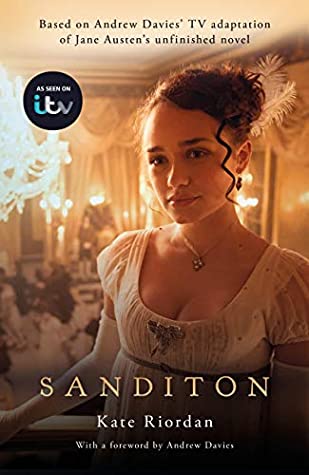Sanditon by Jane Austen and Kate Riordan

When Jane Austen died in 1817, she left 60 pages of an unfinished novel called Sanditon. Kate Riordan took those 60 pages and finished the novel for today's readers. Well, she took the ITV adaptation by Andrew Davies and wrote a book. While I am sure the final product is not what Jane intended, it is a pretty good story.
I started this on my 9 hour drive home from Santa Fe, NM last month. It's an audiobook, but I didn't finish it until just this week. I got tired of seeing it 3/4 complete on my Goodreads home page, so I devoted a few drives to and from work to finishing it.
Charlotte Heywood lives in a little rural backwater where her father is a gentleman farmer. One day a carriage overturns near their home and we are introduced to Tom and Mary Parker. Tom is turning his sleepy seaside town into a resort town and has big plans to make it the talk of the ton. The Parkers invite Charlotte to come with them to Sanditon to see the transformation and make her appearance in society. The town of Sanditon and its inhabitants are what really make this story shine. Tom Parker's brother Arthur and sister Diana are very sweet and hilariously concerned about their health, only they have very bizarre ideas about what is healthy. They are like Mr. Woodhouse, but more gregarious. The local curate, Mr. Hankins, is very like Mr. Collins and Mr. Elton in one man. Pompous and egotistical, but at least he doesn't have a thing for one of the young female characters. Lady Denham is the wealthy old lady who lives at Sanditon House and lords over all the citizens. She has two nieces and a nephew who are hangers on, hoping to inherit her money. They are Clara Brereton and Esther and Sir Edward Denham. Esther and Edward are step-siblings which is good because it is revealed that they have a secret romance going. Ew. Then there is Sidney Parker, Tom's brother. He is handsome and runs in all the right circles, and he is unforgivably rude to Charlotte. Sidney Parker's ward, Georgiana Lamb comes along, too. She is from the Indies and is the daughter of a wealthy plantation owner. She is also black.
The characters are the real stars of this thing. Charlotte herself is pretty naive, so she's more like a Catherine Morland character than an Elizabeth Bennet. On the other hand, she knows enough not to get caught up in all the drama happening around her. She can see it for what it is and move on. The characters are described, but the real understanding of their characters comes from their activities and dialog. It's a great example of showing, not telling.
The villains are much more villainous in this story, than in Austen's novels. The worst offenders are Esther Denham and Clara Brereton. They are competing for both Lady Denham's will and Edward Denham. The things they say to one another and do for revenge would never be seen in Jane's work. She could think of it, but she would never have put it in writing.
The tone of Austen's novels is certainly maintained. Even when the story gets deep or sad or catastrophic for some, the tone is still light. Bad things are not dwelt on for too long and the main character always has enough grace to do the right thing.
The ending is certainly not an Austen ending. I won't tell you, of course, but it doesn't end with a happily ever after for everyone involved. It works for this story, and I don't think it could have done otherwise without some deus ex machina which would definitely just be cheating. It is a satisfactory ending, if not a romantic one.
Overall, I'm giving this 8/10 bookmarks. It isn't ground-breaking material, but I enjoyed it.